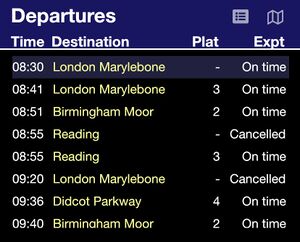SimSig:Disruption Management: Difference between revisions
(Added Code Green & Yellow information) |
mNo edit summary |
||
| Line 5: | Line 5: | ||
Most TOCs use 4 incident levels for grading incidents on the railway to help staff understand the severity of the event in question. The trigger points for incidents vary from TOC to TOC however below is a basic explanation based on a suburban TOCs operating practice. The level of an incident is determined by service control staff and is comunicated out to all impacted staff via verbal and written messages. | Most TOCs use 4 incident levels for grading incidents on the railway to help staff understand the severity of the event in question. The trigger points for incidents vary from TOC to TOC however below is a basic explanation based on a suburban TOCs operating practice. The level of an incident is determined by service control staff and is comunicated out to all impacted staff via verbal and written messages. | ||
All levels can be applied on a network wide or line of route basis. For example, a | All levels above Code Green can be applied on a network wide or line of route basis. For example, a Code Red could be declared on all lines in the West Midlands due to major signalling issues at Birmingham New Street or it could be declared just for the Cross-City line due to a significant train fault. | ||
=== Code Green === | === Code Green === | ||
Revision as of 09:46, 4 February 2021

Just like the real railway things do not always go a planned during our SimSig Sessions with various faults, failures and other disruptive incidents occuring during sessions. As our regular Saturday sessions are intended to provide a level of emersion and realism to operations that is accesable to new and experianced SimSig users alike we have created a disruption management and messaging system that is based of Network Rail and TOC practice. This system is not an exact carbon copy of how things are done on the mainline railway but has been adapted to our needs.
Incident Levels
Most TOCs use 4 incident levels for grading incidents on the railway to help staff understand the severity of the event in question. The trigger points for incidents vary from TOC to TOC however below is a basic explanation based on a suburban TOCs operating practice. The level of an incident is determined by service control staff and is comunicated out to all impacted staff via verbal and written messages.
All levels above Code Green can be applied on a network wide or line of route basis. For example, a Code Red could be declared on all lines in the West Midlands due to major signalling issues at Birmingham New Street or it could be declared just for the Cross-City line due to a significant train fault.
Code Green
Code Green incidents have a low impact on the running of the railway and cause minor delays of upto around 5 minutes for a limited number of services. Code Green incidents are normally isolated events that impact one line of route or a small number of trains. A Code Green incident may result in a limited number of alterations to services but the normal expectation wouldbe that the vast majority of Code Green incidents will resolve themselves through timetabled recovery times.
A Code Green would be declared by service control if one of the following criteria are met:
- An isolated incident delaying up to 2 trains by less than 5 minutes
- An incident not affecting services (e.g. overnight) but with ethe potential to impact train services resuming in the morning
- An incident that was previously classed as YELLOW or RED where service has resumed too normal
Code Yellow
Code Yellow incidents are more serious than Code Green and have a more noticible impact on the running of railway services. A Code Yellow incident is one which is expected to cause delays of between 5 and 20 minutes to a number of trains and which has the possibility of causing disruption to a wider section of the railway.
Below are listed the criteria on which control will judge if an incident is to be catagorised as a Code Yellow
Off Peak
- An incident expected to delay less than 15 trains by less than 15 minutes
Peak
- Incident expected to delay less than 10 trains by less than 5 minutes
- 3 or more alterations/cancellations on the same route due to a single incident
Suburban Line
- More than 3 services running more than 15 mins late
Long Distance Line
- More than 3 services running between 5 and 25 minutes late
Code Red
Code Red incidents are serious events which cause significant delay to train services or impact a large area of the railway. A Code Red incident is generally one which is expected to cause multipul suburban services to be delayed by over 15 minutes and long distance services by over 30 minutes. A Code Red incident will result in significant levels of service alterations and cancellations, Code Red incidents are tthe most disruptive events that will occure randomly in our SimSig sessions.
